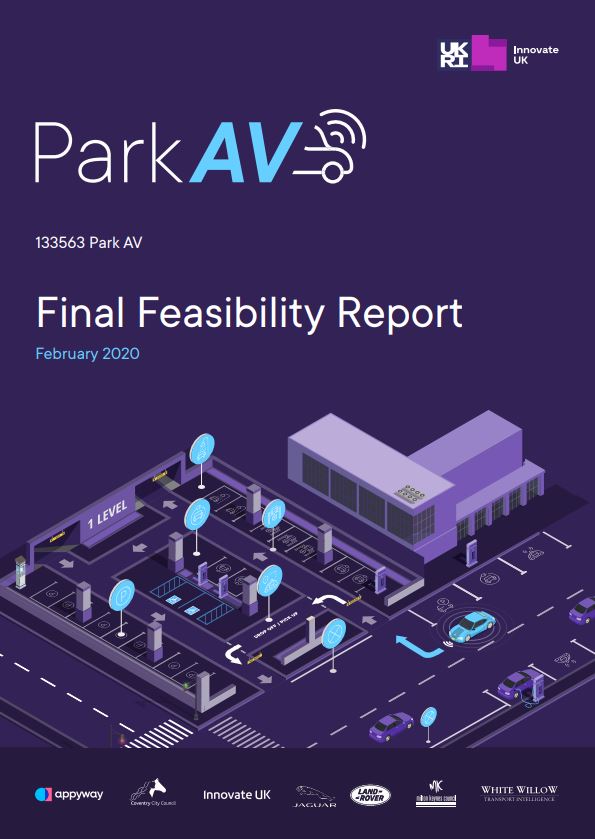The recent Centre for Connected and Autonomous Vehicles (CCAV) funded ParkAV project, composed of AppyWay, Jaguar Land Rover, and Coventry and Milton Keynes Councils, looked specifically at how parking will be impacted by level 4/5 autonomy. Rather than the technical aspects of how the vehicle functions, it looked at the supporting elements and business case for SAE level 4/5 automated valet parking (AVP): logistics, regulation, payment, locating parking, use of land, data exchange, etc, for both on and off street parking.
The consortium found that, in order to facilitate the AVP model, a number of changes need to happen at both national and local government levels. Many of these will not just enable AVP, but also adjustments to the day-to-day approach to setting parking and street/land use policy.
Previously, we discussed the recommended changes from central government to enable autonomous valet parking, however much of the practicalities of parking lie at the local government level. Working with Milton Keynes and Coventry as part of the project, the consortium looked not just at parking but also broader aspects and objectives such as retail access, economic growth, emissions control, and how income is spent. Overall, there is an appetite to look beyond traditional parking operations and to achieve demand management.
The consortium’s recommendations were:
Develop new approaches to more open parking contracts
Currently, parking is largely an enforcement led model that is both labour intensive and expensive to run, and negatively perceived by the public. The consortium suggests developing new approaches such as more open parking contracts which puts the responsibility on the contractor to achieve policy-based outcomes, rather than a supply of a certain number of enforcement hours, for example. These outcomes could include reducing single car occupancy use or promoting the efficient use of spaces. This would allow parking to move from the current enforcement model to an outcome-driven enabling model that supports social good, whilst preserving current income levels from “parking”.
See “MaaSpark” as an enabler of MaaS, not a blocker
The mobility-as-a-service (MaaS) model, which with AVs may include robotaxis, is often a cause of worry for local authorities, as it suggests a model where vehicles cruise while waiting for customers, in contradiction to an authorities’ goals for congestion and parking. These practicalities have sometimes been seen as a blocker for MaaS in urban centres. However, the consortium identified potential ways to manage cruising and a need for parking by MaaS vehicles, dubbed “MaaSpark”.
Traffic regulation orders (TROs or TMOs) that enable “kerb kissing”, or drop-off, by AVs, will help to manage vehicle flow. What’s more, electric automated MaaS vehicles will still require a location to charge, and be cleaned, serviced, and to be kept off the roads at quiet times.
This can also have an impact on land use, enabling councils to reallocate central, more expensive land to other uses and directing parking and servicing to areas outside urban centres.
Develop ways to charge wholesale prices for parking
As suggested above, AVP and MaaSpark will change the demand for parking and how it is used. Shorter stays in urban centres – ie pick-up/drop-offs – and longer stays out of centres, plus requirements for services such as charging and cleaning, may reduce local authority income reliability while increasing costs.
What’s more, uncertainty over future income and models makes it more risky for local authorities to invest in measures to enable AVP and MaaS, and other long term projects or technology.
To mitigate this, the consortium suggests local authorities change their approach to parking contracts to a wholesale one. This would give a guaranteed income for parking land over a set period of time, enabling local authorities to invest in longer term projects without worrying about funding.
This approach would also give more certainty over costs to MaaS and mobility operators, making provision more attractive.
Consider and plan now for future AV parking within new developments
Developers often have the challenge of predicting how use of space will adapt over time.
The impact of AVs on traditional parking, allied to the potential for MaaS services, mean potentially less demand for parking overall in future. There is a potential here for a change in planning requirements, where currently parking would be required to be provided as part of a new development by the developers. In the future, such space might be provided as a pick-up or drop-off zone, with the “parking” at a less costly site that is currently underused. There may then be the potential for developing new sites currently not usable due to lack of land for parking, or to increase the building of developments with little or no onsite parking provision.
Developers can also anticipate a change in use over time, with car parks for example being designed to have floors converted into flats in future, and a more modular approach to development. Centre for London has suggested some ways developers can plan for new mobility models.
AVP and future mobility models have potential to disrupt the local authority approach to not just parking, but to how it manages street use, traffic, developments and meeting social KPIs. The suggested actions from ParkAV try to take the broader needs of local authorities into account, including filling any potential revenue gaps and how to adapt planning to AVP. AppyWay and the consortium members look to support these actions and look forward to engaging with other parties to enable changes and help provide better parking and kerbside use.
For further information on the ParkAV project and for the digitisation of parking and TROs, please contact us here.






